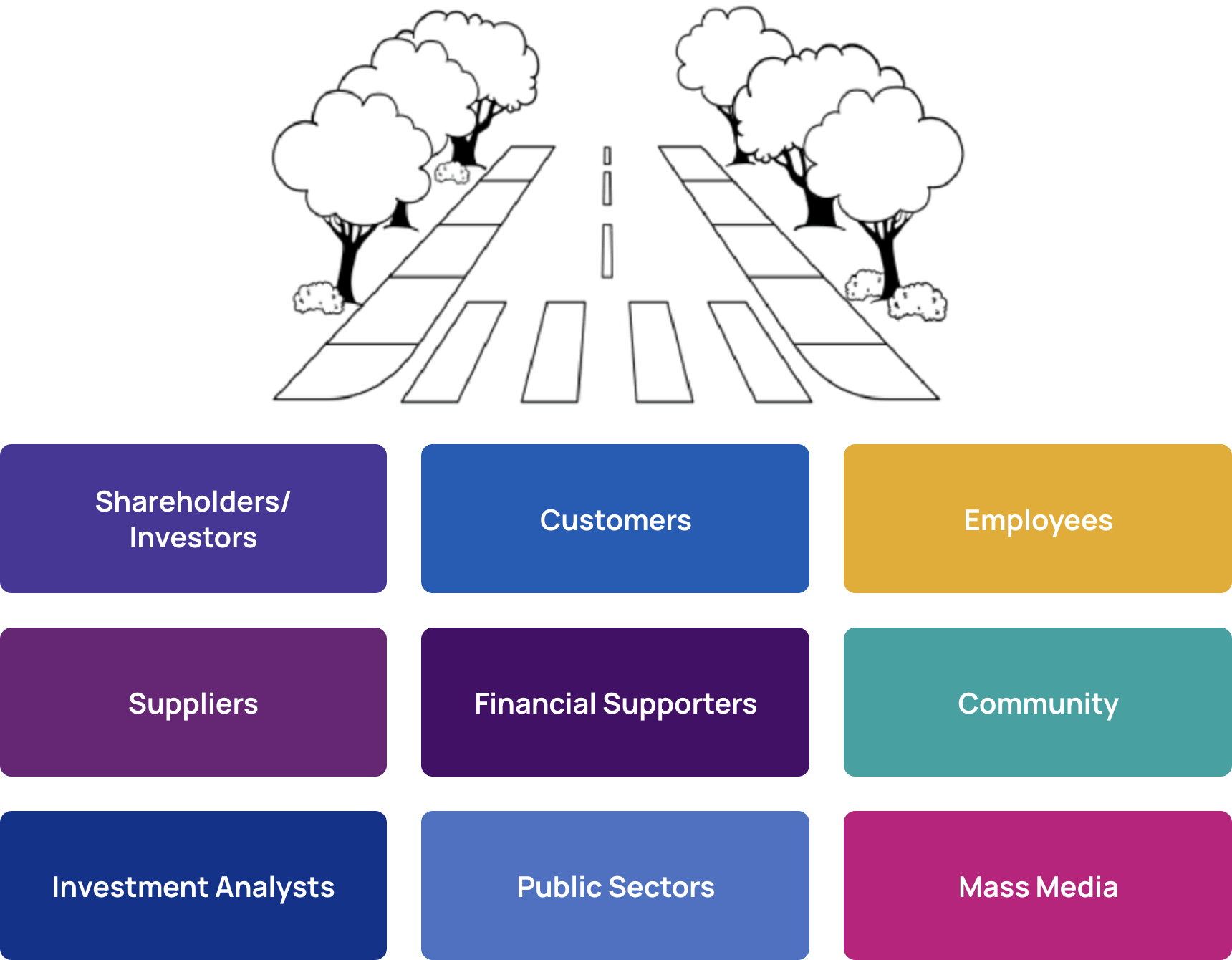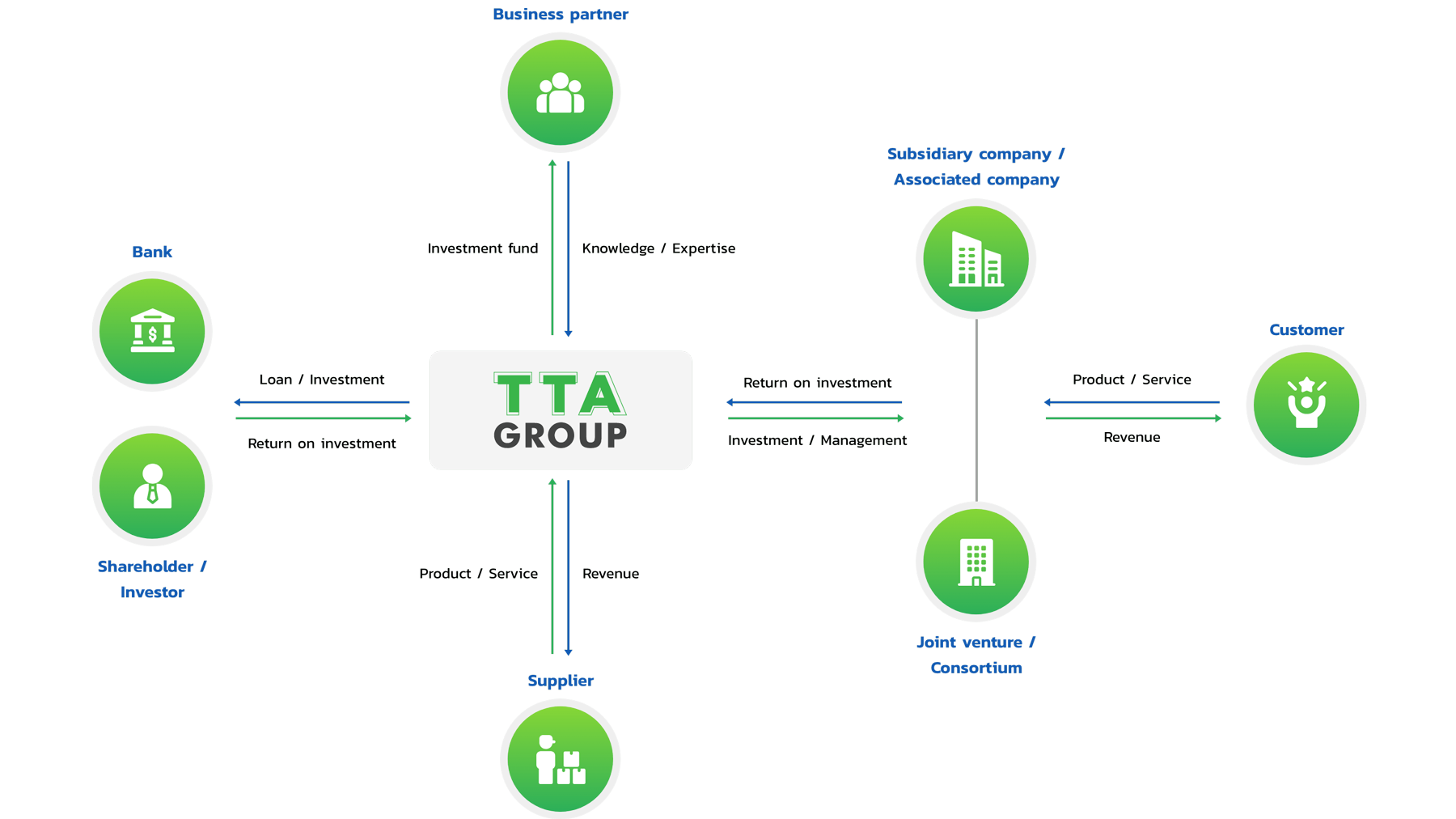Shareholders/Investors
|
- Regularly disclose updating material information about the Company
- Have transparent management, good corporate governance, and social and environmental responsibility
- Increase business competitiveness and operation direction
- Manage the short-term and long-term corporate risk
|
- Shareholders’ Meeting at least once a year
- Business performance disclosure and communication via the Form 56-1 One Report and Sustainability Report
- Brief earnings report via Investor Relations Journal once a quarter
- Participation in the Stock Exchange of Thailand’s Opportunity Day once a quarter
- Management discussion and analysis of the financial statements through the websites of the Company and the Stock Exchange of Thailand once a quarter
- Quarterly investors meetings
- Company visits
- Provision of communication channels e.g., the Company’s website, E-mail, telephone, etc.
- Whistleblowing channels for complaints, opinions, and suggestions
- E-mail
- Mail
- Self-inform to Head of Internal Audit
|
- The Company's performance, business growth, and value addition from new investment
- Disclosure of the progress of Company’s performance.
- Transparent management with good corporate governance principle
- Provision of good quality of products and services
- Environmental management and awareness of reducing global warming
- Business operation with responsibilities for environment, social, and governance and economic (ESG) in accordance with sustainable development guidelines
- Enhancement of value and safety of employees
|
- The Company has disclosed business performance to all investors to present the overall operation and growth of the business.
- The Company has disclosed periodic reports such as quarterly and annual financial report, Management Discussion and Analysis (MD&A), Financial Performance Reviewed (F45-3), and 56-1 One Report, etc.
- The Company has disclosed non-periodic reports such as shareholders’ meetings, asset acquisition and disposition, related party transaction and Company investment, etc.
|
Customers
|
- Respond to customer demand in various dimensions, as well as developing products to meet the customers’ needs
- Have channels for customers to make suggestions about products and services, as well as methods for obtaining advice, solutions, and complaints
|
- After-sales satisfaction assessment form
- Complaint, suggestion, and feedback channels from customers such as call center, e-mail, telephone, and the Company’s website
|
- Quality of products and services
- Provide efficient and timely service
- Products and services that serve a need and are accessible to customers of all ages
- Business operation with responsibilities for environment, social, and governance and economic (ESG) in accordance with sustainable development guidelines
- Privacy and security of customers’ data
- Information through social media
- Ability to solve problems in an appropriate and timely manner
|
- The company has provided and communicated an after-sales satisfaction assessment to customers to continue improving the service quality.
- The company has communicated several complaint channels to customers for receiving suggestions, and feedback along with efficient working team and timely resolution.
- The company has policy to maintain the quality and delivery products on time within brand “Pizza Hut”. For food, the product will be delivered in thermally controlled bags to ensure that the product quality and taste remain high quality, when the product is delivered.
- The company has continuously researched and developed products under the "Pizza Hut" brand to ensure that the products distributed are safe and tasty in accordance with customers’ needs.
|
Employees
|
- Understand and meet employees' needs to create a happy workplace, and continuously promote skill and capacity development
- Communicate directions and disclose information on various operations to keep employees informed about the Company's business activities
- Provide fair compensation and benefits, including proper working conditions, occupational health, and safety in operations
|
- Communication through various channels and online systems within the Company.
- Employee satisfaction and engagement survey
- Whistleblowing channels for complaints, opinions, and suggestions.
- E-mail
- Mail
- Self-inform to Head of Internal Audit
- Portal system, We-Connect Letter, E-mail, video clip, and employees’ group chat.
- Annual party and annual trip for the employees of the Company and its subsidiaries
- MAX Evaluation
|
- Employee benefits and remuneration
- Employee Retention
- Competency development and Career advancement
- Gender equality
- Occupational health and safety workplace
- Good working environment and flexibility
- Transparent management with good corporate governance principle
- Business operation with responsibilities for environment, social, and governance and economic (ESG) in accordance with sustainable development guidelines
|
- The Company has hired and compensated all employees fairly and without discrimination based on race, nationality, religion, sex, age, skin color, disability, financial status, or family lineage.
- The Company has organized training courses relevant to the employees' positions and provided opportunities for career advancement and motivation through a comprehensive compensation package including salary, bonus, health insurance, welfare, a provident fund, overtime pay, increased vacation days, and rewards for loyal employees.
- The Company conducted an employee satisfaction and engagement survey and applied to develop the operation to meet employees’ needs.
- Activities to build organizational engagement
|
Suppliers
|
- Enhance suppliers’ operations to create value
- Support and improve supplier operations to enhance knowledge and achieve the highest level of productivity
- Take care of the environmental and safety conditions in supplier operations
- Support suppliers to have knowledge, understanding and skills for safe operations
- Operate with honesty, transparency, and integrity, provide high-quality products and services at reasonable prices, increase business competitiveness, and provide a direction for future business growth
|
- Supplier Registration
- The Company’s media such as website and investor relations journal
- Whistleblowing channels for complaints, opinions, and suggestions
- E-mail
- Mail
- • Self-inform to Head of Internal Audit
- Supplier Quality Assessment Form
- Annual seminar and meeting
|
- Developing and promoting products and services to enhance the health, nutrition, and well-being of consumers
- System implementation with a defined timeline to increase tracking efficiency
- Business operation with responsibilities for environment, social, and governance and economic (ESG) in accordance with sustainable development guidelines
- Activities that increase organizational engagement and foster a positive working environment
|
- The Company established a Supplier Code of Conduct to promote collaboration for improving and developing the environment and society.
- The Company communicated the Supplier Code of Conduct to suppliers for acknowledgment and compliance.
|
Financial Supporters
|
- Regularly disclose an update on material information about the Company
- Have a transparent management and good corporate governance as well as have a social and environmental responsibility
- Increase business competitiveness and expand business direction
- Manage the short-term and long-term corporate risk
|
- Company visits
- Provision of communication channels e.g., the Company’s website, E-mail, telephone, and etc.
|
- Business conduct with more responsibilities on environmental impacts
|
- The Company has emphasized sustainability operations that consider impacts in all dimensions and the impacts of all stakeholders.
- The Company always updates the information on its website to communicate accurate and up-to-date information to financial supporters.
|
Community
|
- Respect community rights and take care of the environment of the surrounding community
- Improve the quality of life and enhance the benefits and happiness of the community and society
- Disclose the Company's information and operating results accurately and in a timely manner
- Possess knowledge and understanding of the Company's operations
|
- Social and environmental activities
- Whistleblowing channels for complaints, opinions, and suggestions
- E-mail
- Mail
- • Self-inform to Head of internal audit
|
- Innovation to promote sustainable community development
- Awareness of the environment and efficient resource utilization
|
- The Company was continuously arranging the CSR (Corporate Social Responsibility) after process and CSR in process activities for community.
- The Company has addressed social issues by developing the BUDDY THAI application to prevent violence and bullying in children.
|
Investment Analysts
|
- Regularly update essential information about the Company’s financial position
- Support information as required by investment analysts
|
- Quarterly analyst meetings
- Company visits
- Provision of communication channels e.g., the Company’s website, E-mail, telephone, and etc.
|
- Disclosure of the Company’s performance progress
- Transparent management with good corporate governance principle
- Business operation with responsibilities for environmental, social, and governance and economic (ESG) in accordance with sustainable development guidelines
|
- The Company constantly updated its website information to ensure that it is up-to-date and accurately communicates information to investment analysts.
- The Company has disclosed periodic reports such as quarterly and annual financial report, Management Discussion and Analysis (MD&A), Financial Performance Reviewed (F45-3), and 56-1 One Report, etc.
|
Public Sectors
|
- Be a good model to other companies in terms of transparent and excellent management
- Collaborate with government agencies and present effective strategies towards sustainable development
|
- Business performance disclosure and communication via the Form 56-1 One Report
- Performance of Safety Officers report
- Continuous communication through phone, E-mail, and the Company’s website
- Whistleblowing channels for complaints, opinions, and suggestions
- E-mail
- Mail
- Self-inform to Head of Internal Audit
|
- Support, promote, and develop the potential of people in society.
|
- The Company constantly updated its website information to ensure that it is up-to-date and accurately communicates information to support public sectors.
- The Company has disclosed business performance to present the overall operation and growth of the business. • The Company has disclosed periodic reports such as quarterly and annual financial report, Management Discussion and Analysis (MD&A), Financial Performance Reviewed (F45-3), and 56-1 One Report, etc.
- The Company has complied with related laws, rules, and regulations.
|
Mass Media
|
- Regularly disclose an updating material information about the Company
|
- Annual meeting of the Company
- Provision of communication channels e.g., the Company’s website, E-mail, telephone, articles, news, and etc.
|
- Improve organizational processes to meet the current trend
- Efficient communication
|
- The Company constantly updated its website information to ensure that it is up-to-date and accurately communicates information to support mass media.
- The Company has disclosed business performance to present the overall operation and growth of the business.
- The Company has disclosed periodic reports such as quarterly and annual financial report, Management Discussion and Analysis (MD&A), Financial Performance Reviewed (F45-3), and 56-1 One Report, etc.
|




